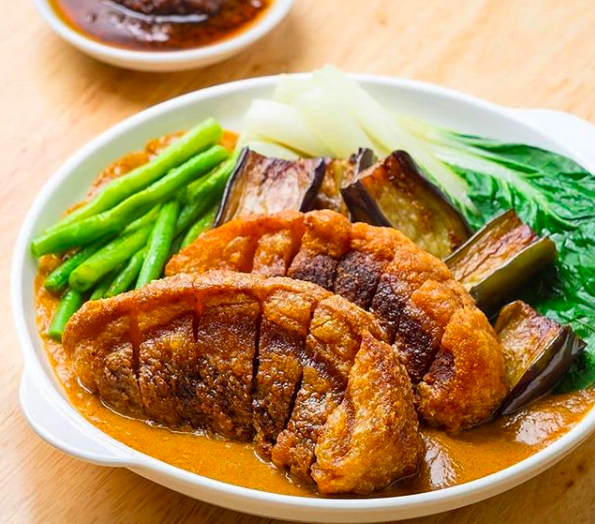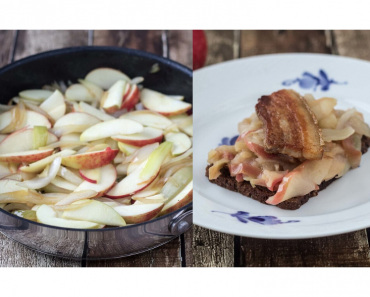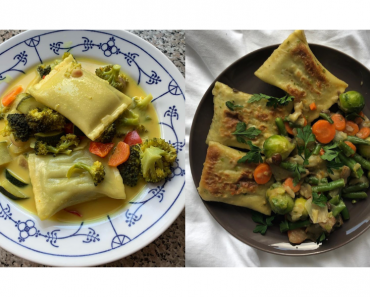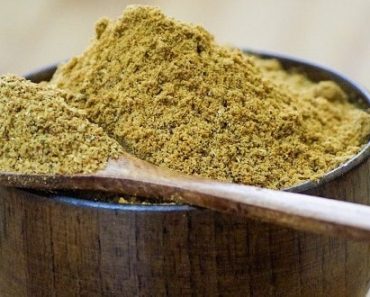Kare-kare is a Filipino-style beef stew that is accompanied by a thick savory peanut sauce. It is made of stewed oxtail, pork hocks, calves’ feet, pig feet, beef stew food, and sometimes offal or tripe.
Even kare-kare can be made from seafood such as prawns and squid, or vegetables. Add vegetables like eggplant, Chinese cabbage, or other greens, daikon, green beans, okra, and asparagus beans — usually equivalent to or exceeding beef. The stew is flavored with peanuts or peanut butter, onions, and garlic roasted on the ground.
This dish is made from Palayok or clay pot. It also serves as the serving bowl at the same time. Pairing it with plain white rice is the best way to eat kare-kare. Bagoong alamang or fermented paste of shrimp completes the taste of the dish.
KARE-KARE: PEANUT-BASED BEEF STEW
- Author: Romae Chanice Marquez
- Recipe Category: Main Dish
- Cuisine: Filipino
Ground peanuts and toasted rice are the secrets to the best tasting kare-kare. Those two ingredients are responsible for the sauce that is thickened and the nutty taste that will never lose its consistency. The whole preparation and cooking time is for 1 hour and 40 minutes. This recipe is suitable for six servings.

Kare-kare is one of the most famous dishes in the Philippines, served in most local restaurants. Photo credits to: @filipinofoodmovementau.
Kare-Kare: Peanut-Based Beef Stew Ingredients
- 1/4 kilo tripe cut into squares (rinse with salt to taste)
- 2 tablespoons of vinegar
- 1/4 cup of cooking oil
- 2 teaspoons of atsuete seeds
- 2 medium red onions, peeled, chopped
- 4 cloves of garlic, peeled, chopped
- 1/2 kilo beef shanks cut 1-inch thick
- 1 bunch of string beans, cut into 3-inch lengths
- 3 eggplants, cut into wedges
- 3 bunches of pechay
- 1/2 cup of peanuts, pounded into a paste
- 1/4 cup of rice, toasted, pounded into a powder
- Bagoong, to serve
Kare-Kare: Peanut-Based Beef Stew Instructions
Step 1: Add tripe, vinegar, and enough water to cover in a pressure cooker over medium heat. Take it to a boil. Boil, discard water, and refill for 10 minutes. Cover and lock the cover again. Simmer for about 40 minutes until the tripe is tender. Dispose of water and set aside the ride.
Step 2: In the meantime, heat oil in a pot over medium heat. Fill in the atsuete. Cook to release the light, occasionally stirring. To slice and discard seeds, use a slotted spoon. Cook until softened, add the onion. Cook until fragrant, add garlic.
Step 3: Move the mixture to the cooker for pressure. Remove the shanks of pork and the tripe. Pour in enough water to cover it. Bring to a boil and bake. Remove any scum that rises to the surface and remove it. Cook for about 30 minutes until soft.
Step 4: Unlock the lid then release pressure. Attach peas, eggplants, and pechay to the line. Mix peanut paste together with toasted rice powder. Return to the saucepan and stir. Simmer, let it thicken. Serve with a bagoong.
Kare-Kare: Peanut-Based Beef Stew Additional Information
- Per serving has 239 calories, 10g of carbohydrates, 21g of fat, and 7g of protein.
- It is essential to have the proper ratio of ingredients to achieve the ideal consistency of the peanut sauce. It should not be too thick or very thin.
- This recipe serves 6.
- Cook/prep time is 1 hour and 40 minutes.
About Kare-Kare: Peanut-Based Beef Stew Recipe
There are several historical stories about kare-kare’s origins. The first is that it came from Pampanga. One has it from the Moro elite’s royal dishes that settled in Manila before settling in Spain.
Several versions of kare-kare are available, but every version has something to do with the meat component. Tripe is a great ingredient to use, as well. Some versions use other meat types, including seafood.
Conclusion
Specific flavors may be added, but the dish is one of the most delicious dishes in the Philippines. For more international recipes, click here.
Featured Image: @my_kusina_ph / Instagram, @karenskitchen0624 / Instagram







